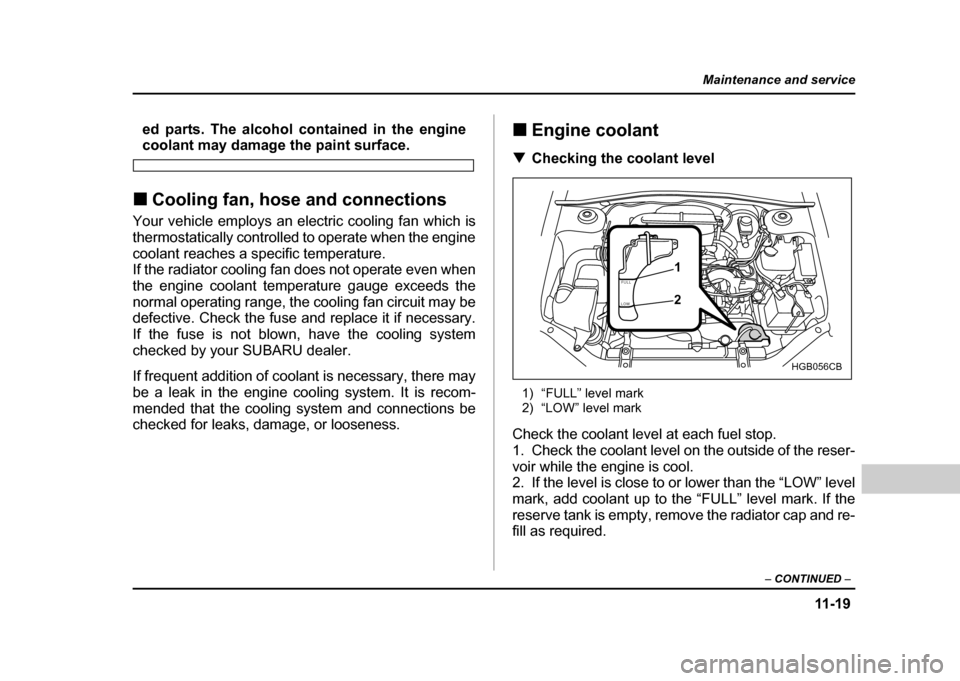Page 404 of 491

11 -1 9
Maintenance and service
– CONTINUED –
ed parts. The alcohol contained in the enginecoolant may damage the paint surface.
! Cooling fan, hose and connections
Your vehicle employs an electric cooling fan which is
thermostatically controlled to operate when the engine
coolant reaches a specific temperature.
If the radiator cooling fan does not operate even when
the engine coolant temperature gauge exceeds the
normal operating range, the cooling fan circuit may be
defective. Check the fuse and replace it if necessary.
If the fuse is not blown, have the cooling system
checked by your SUBARU dealer.
If frequent addition of coolant is necessary, there may
be a leak in the engine cooling system. It is recom-
mended that the cooling system and connections be
checked for leaks, damage, or looseness. !
Engine coolant
! Checking the coolant level
1) “FULL” level mark
2) “LOW” level mark
Check the coolant level at each fuel stop.
1. Check the coolant level on the outside of the reser-
voir while the engine is cool.
2. If the level is close to or lower than the “LOW” level
mark, add coolant up to the “FULL” level mark. If the
reserve tank is empty, remove the radiator cap and re-
fill as required.
FULL
LOW
HGB056CB
1 2
Page 406 of 491
11 -2 1
Maintenance and service
– CONTINUED –
Never attempt to remove the radiator cap until
the engine has been shut off and has cooled
down completely. Since the coolant is under
pressure, you may suffer serious burns from a
spray of boiling hot coolant when the cap is re-
moved.
4. Install the under cover.
Non-turbo models
1) Filler neck
2) Fill up to this level Turbo models
1) Filler neck
2) Fill up to this level
5. Slowly pour the coolant and fill to the radiator filler
neck. Do not pour the coolant too quickly, as this may
lead to insufficient air bleeding and trapped air in the system.
1
2
UGB508BB
1
2
USB518BB
Page 407 of 491
11 - 2 2
Maintenance and service
Guideline of coolant quantity (including coolant in reservoir tank):
Non-turbo models: MT. 7.4 US qt (7.0 liters, 6.2 Imp qt)
AT. 7.3 US qt (6.9 liters, 6.1 Imp qt)
Turbo models: MT. 8.1 US qt (7.7 liters, 6.8 Imp qt)
AT. 8.0 US qt (7.6 liters, 6.7 Imp qt)
1) “FULL” level mark
2) “LOW” level mark
" Be careful not to spill engine coolant when
adding it. If coolant touches the exhaust pipe, it
may cause a bad smell, smoke, and/or a fire." Do not splash the engine coolant over paint-
ed parts. The alcohol contained in the engine
coolant may damage the paint surface.
6. Pour the coolant and fill to the reservoir tank’s
“FULL” level mark.
1) Rubber gaskets
FULL
LOW
HGB056CB
1 21
HSB026BB
Page 408 of 491

11 -2 3
Maintenance and service
– CONTINUED –
7. Put the radiator cap back on and tighten firmly. At
this time, make sure that the rubber gasket in the radi-
ator cap is correctly in place.
8. Start and run the engine for more than five minutes
at 2,000 to 3,000 rpm.
9. Stop the engine and wait until the coolant cools
down (122 to 140 °F [50 to 60 °C]). If there is any loss
of coolant, add coolant to the radiator’s filler neck and
to the reserve tank’s “FULL” level.
10.Put the radiator cap and reservoir cap back on and
tighten firmly.Air cleaner element
The air cleaner element functions as a filter screen.
When the element is perforated or removed, engine
wear will be excessive and engine life shortened.
The air cleaner element is a viscous type. It is unnec-
essary to clean or wash the element.
Do not operate the engine with the air cleaner
element removed. The air cleaner element not
only filters intake air but also stops flames if the
engine backfires. If the air cleaner element is
not installed when the engine backfires, you
could be burned.
! Replacing the air cleaner element
! Non-turbo models
Replace the air cleaner element according to the
maintenance schedule in the “Warranty and Mainte-
nance Booklet”. Under extremely dusty conditions, re-
place it more frequently. It is recommended that you
always use genuine SUBARU parts.
Page 483 of 491

14-4
Index
Front
........................................................................... 11-33
Rear ............................................................................ 11-34
Dimensions .................................................................... 12-2
Disarming the system ................................................ 2-17
Disc brake pad wear warning indicators ............7-29
Dome light ............................................................ 6-2, 11-77
Door locks ....................................................................... 2-3
Door open warning lights .........................................3-25
Drive belts ....................................................................... 11-27
Driver’s control center differential ........................7-18
Auto indicator light ................................................ 3-26
Indicator light .......................................................... 3-27
Driving
Drinking ..................................................................... 8
Drugs .......................................................................... 9
Foreign countries .................................................. 8-6
Mobile phone .......................................................... 10
Pets ............................................................................. 10
Tips ........................................................... 7-14, 7-17, 8-7
Tired or sleepy ........................................................ 9
Snowy and icy roads ............................................ 8-13
E
EBD (Electronic brake force distribution) system ......................................................................... 7-32
Electrical system .......................................................... 12-3Electronic Brake force Distribution (EBD)
system .......................................................................... 7-32
Emergency Locking Retractor (ELR) ...................1-14
Engine Compartment overview ........................................11-8
Coolant ....................................................................... 11-19
Exhaust gas (Carbon monoxide) .....................8, 8-3
Hood ............................................................................ 11-5
Oil ................................................................................. 11-11
Overheating .............................................................. 9-16
Starting ....................................................................... 7-9
Stopping ..................................................................... 7-11
Exterior care ................................................................... 10-2
F
Flat tires ............................................................................ 9-5
Floor mat .......................................................................... 6-13
Fluid level
Automatic transmission .......................................11-31
Brake ........................................................................... 11-37
Clutch .......................................................................... 11-38
Power steering ........................................................ 11-36
Fog light switch ............................................................. 3-35
Folding down the rear seat .......................................1-12
Front Differential gear oil ................................................. 11-33
Fog light ..................................................................... 11-73